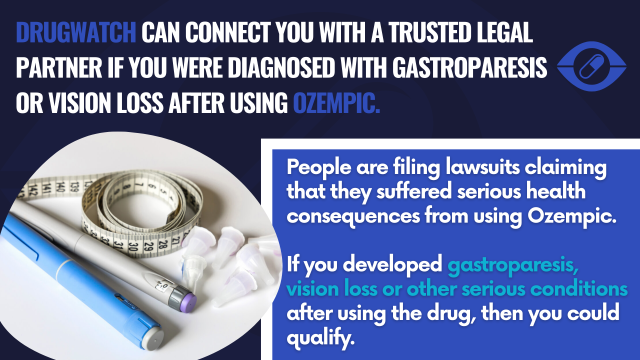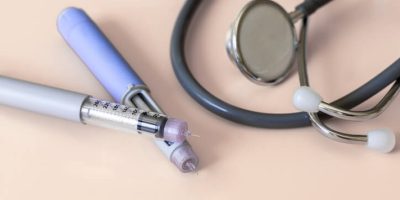Ozempic Lawsuit
Ozempic lawsuits are raising new concerns about blindness. People filing Ozempic vision loss lawsuits say they were not warned about the risk of NAION, a type of optic nerve damage that can cause vision problems. Meanwhile, lawsuits that claim gastroparesis, ileus and intestinal blockage are ongoing. The first Ozempic stomach paralysis lawsuit was filed on Aug. 2, 2023, but so far, no settlements have been reached.
See If You Qualify for a Weight Loss and Diabetes Drug Lawsuit
You may be entitled to compensation if you were injured after taking a medication like Ozempic, Saxenda or Wegovy. For a free case review, complete the form or call 866-898-3173.
- A+BBB Rating
- 4.9 StarGoogle Reviews
- A+BBB Rating
- 4.9 StarGoogle Reviews
Our content is developed and backed by respected legal, medical and scientific experts. More than 30 contributors, including product liability attorneys and board-certified physicians, have reviewed our website to ensure it’s medically sound and legally accurate.
legal help when you need it most.
Drugwatch has provided people injured by harmful drugs and devices with reliable answers and experienced legal help since 2009. Brought to you by Wilson & Peterson LLP, we've pursued justice for more than 20,000 families and secured $324 million in settlements and verdicts against negligent manufacturers.
More than 30 contributors, including mass tort attorneys and board-certified doctors, have reviewed our website and added their unique perspectives to ensure you get the most updated and highest quality information.
Drugwatch.com is AACI-certified as a trusted medical content website and is produced by lawyers, a patient advocate and award-winning journalists whose affiliations include the American Bar Association and the American Medical Writers Association.
About Drugwatch.com
- 15+ Years of Advocacy
- $324 Million Recovered for Clients
- 20,000 Families Helped
- A+ BBB Rating
- 4.9 Stars from Google Reviews
Testimonials
I found Drugwatch to be very helpful with finding the right lawyers. We had the opportunity to share our story as well, so that more people can be aware of NEC. We are forever grateful for them.
- Legally reviewed by Trent B. Miracle, Esquire
- Last update: December 3, 2025
- Est. Read Time: 12 min read
- Litigation status: Lawsuits involving Ozempic and other GLP-1 drugs have been grouped together in multidistrict litigation (MDL), helping to expedite the legal process. The New Jersey Supreme Court is also currently deciding whether Ozempic vision loss lawsuits will be grouped together into a multicounty litigation, or MCL.
- Number of lawsuits: 2,947 as of December 2025.
- Injuries Claimed: Severe gastroparesis (stomach paralysis), ileus (impaired bowel function), intestinal obstruction and permanent vision loss from non-arteritic anterior ischemic optic neuropathy (NAION).
- Label status: In January 2025, the Ozempic label was updated to state that it is “not recommended in patients with severe gastroparesis,” but does not indicate that the drug itself may cause the condition. In September 2023, the U.S. Food & Drug Administration (FDA) added ileus warnings to Ozempic.
- Settlements: No global settlements have been announced as of December 2025.
Why Are People Filing Ozempic Lawsuits?
Currently, most of the people who have filed Ozempic lawsuits did so because they suffered severe stomach side effects, such as gastroparesis, ileus or intestinal blockage.
However, emerging lawsuits claim the drug caused an eye condition called non-arteritic anterior ischemic optic neuropathy (NAION).
The lawsuits are based on the fact that the manufacturer, Novo Nordisk, knew or should have known that Ozempic could lead to these severe side effects but didn’t warn people about the risks.
- Failure to warn of side effects.
- Manufacturers knew or should have known about the risks.
- Manufacturers made false, misleading or incomplete representations of safety.
Since the FDA approved Ozempic in 2017, the drug’s manufacturer, Novo Nordisk, has not included warnings that the medication can cause gastroparesis in its prescription information. The company has warned about other Ozempic side effects.
In September 2023, the FDA added an Ozempic warning for ileus. Ileus is a condition that causes the intestines to stop working properly. In January 2025, a warning for severe gastrointestinal adverse reactions was added.
While there is no mention of NAION specifically, the label cautions that “vision changes” are a potential serious side effect and highlights concerns about diabetic retinopathy.
- NAION
- Blindess
- Vision Loss
- Gastroparesis
- Ileus
- Intestinal obstruction
- Intestinal pseudo-obstruction
- Other gastrointestinal injuries
There is no cure for NAION or gastroparesis. Plaintiffs are seeking compensation for loss of quality of life, past and future medical bills, and other damages.
Ozempic (semaglutide) belongs to a class of drugs called GLP-1 agonists, and lawyers are also investigating other drugs in this class.
- Wegovy (semaglutide)
- Mounjaro (tirzepatide)
- Rybelsus (semaglutide tablets)
- Saxenda (liraglutide)
- Trulicity (dulaglutide)
- Zepbound (tirzepatide)
If you were diagnosed with NAION or gastroparesis after using Ozempic or another GLP-1 drug, you may qualify for a lawsuit.
What Medical and Legal Experts Say About Ozempic Injuries
Ozempic Vision Loss Lawsuits
Lawyers are investigating Ozempic vision loss and blindness lawsuits. A 2024 study published in JAMA Ophthalmology reported that patients with Type 2 diabetes who took semaglutide-containing medications had more than a fourfold higher risk for developing non-arteritic anterior ischemic optic neuropathy (NAION) compared with patients not on a GLP-1 agonist.
Overweight people who took semaglutide for weight loss had a more than sevenfold higher risk.
Another 2024 study, involving more than 400,000 patients in the Netherlands, found that people with Type 2 diabetes who used semaglutide had more than double the risk of developing NAION compared to those who didn’t take the drug.
While the FDA has yet to require a warning for NAION on Ozempic and other semaglutide labels, there has been international action on the link.
In June 2025, the World Health Organization (WHO) warned that semaglutide drugs, such as Ozempic, Wegovy and Rybelsus, may rarely cause NAION. The WHO advises patients to seek medical care immediately if they notice rapid changes in their eyesight. It also recommended that doctors should discontinue treatment if NAION is confirmed.
Just weeks before the WHO decision, the European Medicines Agency — the European Union’s counterpart to the FDA — found that NAION is a very rare side effect of semaglutide medicines. Approximately 1 in 10,000 users of drugs like Ozempic, Wegovy and Rybelsus may be affected.
In addition, a 2024 study found that people taking another GLP-1 drug, liraglutide, had a 179% higher risk of developing NAION. This has led to Victoza and Saxenda lawsuits. Both contain liraglutide as their active ingredient.
NAION occurs when blood flow to the optic nerve stops. Researchers think that GLP-1 drugs could affect blood flow to the optic nerve, leading to the development of the eye condition.
- Sudden, painless vision loss in one eye (often noticed upon waking up)
- Trouble seeing colors clearly or washed-out colors
- Light sensitivity
- Blurry or dim vision
- A shadow or darkened area in your vision
- Missing areas in your vision (blind spots)
To file an Ozempic vision loss lawsuit, you will need to be diagnosed with NAION. The condition is usually diagnosed through a doctor’s exam and patient history, especially if risk factors and typical symptoms are present. Extra tests are only needed if signs are unusual or suggest another eye problem. Doctors focus on ruling out conditions that mimic NAION, since some are more dangerous and require urgent treatment.
- Clinical examination: The primary method for diagnosing NAION.
- Rule out mimics: Other vision conditions such as giant cell arteritis, optic neuritis or orbital lesions.
- Testing if needed: Blood tests, biopsy or imaging (MRI, ultrasound).
- Ocular imaging: Specialized imaging techniques specifically designed for the eye can aid in challenging cases.
- Younger patients: These people may need tests for blood clotting issues, optic disc drusen or sleep apnea to rule out other conditions.
It’s essential to save these medical records and reports if you plan to file an Ozempic lawsuit.

Trent B. Miracle, Esq. discusses Ozempic vision loss lawsuits, including how people may qualify to file a claim.
- How do I know if I qualify for an Ozempic vision loss lawsuit?
If you have previously been prescribed semaglutide products like Ozempic or Wegovy and suffered vision loss you may qualify. Specifically, if you have suffered nonarteritic ischemis optic neuropathy (NAION) and took either of these drugs you likely qualify to file suit.
- What is the science on how Ozempic causes vision loss?
The link between NAION and these products isn’t specifically known at this time. It is possible that semaglutide interferes with vascular healthy and blood flow resulting in an ischemic event restricting blood flow to the optic nerve. Individuals with diabetes are already predisposed to vascular complications so introducing semaglutide to the mix could cause such an injury.
- What can I expect if I contact a law firm about a potential vision loss case?
The firm will gather information about your use of semaglutide, your medical history and this specific injury in order to made a determination on whether to proceed on your behalf. This process likely involves reviewing your medical and pharmaceutical records as well.
Injuries Named in Ozempic Stomach Paralysis Lawsuits
One of the main injuries claimed in the Ozempic lawsuits is gastroparesis (paralyzed stomach).
Gastroparesis is a severe disorder that causes food to move too slowly through the stomach to the small intestine. In some cases, food may stop moving altogether, causing nausea, stomach pain and vomiting.
In addition to gastroparesis, lawyers are investigating cases of ileus, intestinal obstruction or pseudo-obstruction, and other gastrointestinal injuries. Chronic vomiting is one of the main signs of gastroparesis, and some people who filed lawsuits experienced persistent vomiting after taking Ozempic.
It’s important to note that not everyone who takes semaglutide will develop severe side effects.
“The most common side effects would be GI side effects. Nausea, vomiting, a feeling of fullness. Maybe some reflux, like regurgitation, like you taste your food a little bit after you eat,” said Dr. Sue Decotiis, a medical weight loss physician who often prescribes semaglutide and tirzepatide on her medically supervised program.
Do not stop taking Ozempic or any other medication without first consulting your physician. You should talk to your doctor if you experience specific symptoms that could be signs of a severe gastrointestinal injury.
- Abdominal fullness or gas
- Abdominal pain and cramping
- Abdominal swelling (bloating)
- Acid reflux
- Belly pain
- Breath odor
- Changes in blood sugar levels
- Constipation
- Diarrhea
- Feeling full after eating just a few bites
- Feeling full long after eating a meal
- Inability to pass gas
- Nausea and vomiting
- Not wanting to eat
- Painful abdominal cramps that come and go
- Vomiting undigested food eaten hours earlier
- Weight loss and not getting enough nutrients
You may qualify to file an Ozempic lawsuit if you took Ozempic for weight loss or any other indication and experienced gastroparesis. Lawyers are currently accepting cases from people who suffered severe gastroparesis resulting in vomiting for four weeks or more.
You may not qualify if you have had gastric bypass surgery, gastric banding or gastric sleeve surgery before taking Ozempic. Additionally, lawyers are not taking Ozempic cases for those being treated for cancer.
These criteria are guidelines, and only an Ozempic lawyer can tell you if you qualify to file a lawsuit. Fill out our free case review form to explore your legal options.
How To File an Ozempic Lawsuit
If you want to file an Ozempic lawsuit, there are a few steps to follow. Drugwatch can help you with the process.
- Continue Getting Medical Care: It's essential to maintain your ongoing medical treatment. This helps track your injury and support your case.
- Save Your Medication Packaging: Hold onto everything related to Ozempic, including the boxes, prescription labels and any packaging. These serve as proof that you used the medication.
- Collect Your Medical Records: Gather all relevant documents, such as pharmacy receipts, medical records, lab results and discharge summaries. Keeping everything organized is crucial for your claim.
- Contact a Lawyer: Find an attorney who has experience with Ozempic injuries. They can help review your case and guide you through the necessary paperwork.
- File a Lawsuit: When your lawyer files your lawsuit, your case might join a special group of similar cases. This makes it easier to handle the pretrial process under one judge.
- Sharing Evidence: Both sides will exchange information and expert opinions. This part helps to strengthen your case by gathering more proof of your injury and medical history.
- How Your Case Is Resolved: Your case could either be settled or go to trial. If your case is part of a larger group and isn’t settled, it may be sent back to your local court for a trial.
Many lawyers work on a “contingency fee” basis, which means you only pay them if they win your case. In the first 30 days, your lawyer will collect your medical records, determine if you have a strong case and provide guidance on what to do next.
Meanwhile, report your injuries to the U.S. Food and Drug Administration’s MedWatch program, which tracks medical injuries from medications.

You Have a Limited Time To File an Ozempic Lawsuit
If you’re considering an Ozempic lawsuit, it’s crucial to understand the statute of limitations. This law dictates how long you have to file a case after being injured. It may be as little as one year, depending on your state.
If you miss this deadline, you could lose your chance for compensation.
- Discovery rule
- This rule allows the filing deadline to start when you first recognize your injury, not when it actually happened. This is because sometimes you may not be aware of a side effect of medication or surgery immediately. It may take time for the injury to become apparent.
- Tolling
- This pauses the time limit in certain situations, including when the injured person is a minor or unable to act. For instance, a child injured in an accident has extra time to file once they turn 18.
Since each state has different rules, it’s wise to check your state’s laws or consult a lawyer to ensure you understand your deadlines and protect your rights.
An Attorney Can Help You Gather Evidence for Your Case
An Ozempic attorney can help you gather information that can help determine if you have a case.
- A timeline showing when your symptoms started and how they relate to your use of Ozempic.
- Pharmacy records that detail the history of your prescriptions and refills.
- Labels from medication bottles that show when your prescriptions were filled.
- Medical reports from hospital visits that explain treatments for stomach or vision issues.
- For vision claims: Ophthalmologist records that show any loss of vision, including tests that measure sight and scans for diagnosing conditions like NAION.
- For stomach claims: Results from tests that check how quickly food leaves the stomach, which help confirm conditions like gastroparesis.
People Who Filed Ozempic Lawsuits
Real-world filings illustrating alleged injuries and timelines.
Jaclyn Bjorklund (combined Ozempic + Mounjaro case)
According to Jaclyn Bjorklund’s complaint, which combines an Ozempic lawsuit and a Mounjaro lawsuit, she had gastrointestinal problems after she used Ozempic and Mounjaro. She took Ozempic for more than a year before she stopped using it in July 2023 and switched to Mounjaro. She experienced gastroparesis that caused severe vomiting, which led to her teeth falling out.
Bjorklund was forced to visit the emergency room several times and was hospitalized with symptoms that included stomach pain, gastrointestinal burning and throwing up whole food only hours after eating. She now takes additional medications for excessive vomiting.
Her case was one of the first nine consolidated into MDL 3094.
Source: Borkland v. Novo Nordisk, 2:2023cv01020
Laura Marrero
Laura Marrero filed her Ozempic lawsuit in December 2023 after she had been taking the medication from May 2023 to October 2023 and suffered persistent vomiting the entire time she took the drug. In August 2023, Marrero ended up in the hospital with abdominal pain, nausea, vomiting, difficulty swallowing and rectal bleeding.
Her nurse practitioner told her to stop taking Ozempic in October 2023 because of severe side effects, including persistent vomiting.
“As a direct result of Ms. Marrero’s use of Ozempic, she suffered and continues to suffer from complications causing her damage, including but not limited to pain, suffering, mental anguish, depression, loss of enjoyment of life, medical expenses and other out-of-pocket losses, and loss of income.”
Source: Marrero v. Novo Nordisk et al. 2:2023cv05036
Marrero’s case was transferred to MDL 3094 on Feb. 26, 2024.

Mass torts and product liability attorney Jonathan Sedgh answers important questions about Ozempic gastroparesis lawsuits.
- Why are you filing lawsuits against the makers of Ozempic and other GLP-1 drugs?
We’re filing lawsuits against these drugmakers for failing to properly warn people of the risk of gastroparesis, ileus and intestinal blockages.
- What type of science is there that links these drugs to these side effects?
There are some publicly available clinical trials, observational studies and case reports showing an association between gastroparesis or persistent vomiting and Ozempic and these types of drugs.
- What kind of warnings are currently on these drug labels?
At the time we first started pursuing this litigation, Mounjaro was probably the only label that listed something related to gastroparesis, but it is in no way adequate. The rest of the medications do not mention anything in the Warning section about vomiting, gastroparesis, stomach being frozen or stomach paralysis. We believe that they should have at least told the FDA or suggested to the FDA that there should be some sort of warning there. It wasn’t until September 2023 that the FDA required a warning for ileus and intestinal blockage for these drugs.
- If people believe they were injured by Ozempic or another one of these drugs, how do they know if they qualify for a lawsuit?
If you’ve been vomiting for more than a few weeks, it’s worth giving us a call. We could hear your story just to see what the facts are in your case. Sometimes there are nuances, so if somebody has a few ER visits but was only vomiting for two or three weeks, that’s something we would look at.
Latest Ozempic Lawsuit Updates
We are still waiting to hear if Ozempic NAION lawsuits will be consolidated in a New Jersey multicounty litigation (MCL).
After the period for public comments closed on Aug. 29, the Administrative Director of the New Jersey Courts was required to submit the application and the feedback to the New Jersey Supreme Court. The court is reviewing all the information to determine whether to establish a special legal process for cases related to Ozempic. If the court decides to move forward, it will assign a judge to oversee the cases and announce this decision publicly.
As of December 2025, there are 2,947 personal injury lawsuits for gastroparesis, ileus and intestinal obstruction in MDL 3094 in the Eastern District of Pennsylvania. Federal judge Karen S. Marston is presiding over the MDL.
Ozempic Lawsuit Timeline
-
December 2, 2025: Modest Growth for Ozempic Gastroparesis MDL
There are now 2,947 active lawsuits in the MDL focused on claims involving GLP-1 drugs and intestinal conditions like gastroparesis. This means about 30 new cases have been filed over the last month. Keep in mind that similar cases have now also been consolidated in New Jersey state court.
-
November 20, 2025: Ozempic Vision Loss and Gastroparesis Lawsuits Consolidated in New Jersey
The New Jersey Supreme Court has approved the creation of two multicounty litigations (MCLs) involving Ozempic. MCLs are used in New Jersey when many similar cases are filed in the state, grouping all of those cases together before a single judge for coordinated proceedings. New Jersey has become a hotbed for lawsuits involving Ozempic since Novo Nordisk's U.S. headquarters are in the state. Now, separate MCLs have been created to handle both vision loss and gastroparesis lawsuits involving GLP-1 drugs.
-
November 3, 2025: Ozempic Gastroparesis MDL Approaches 3,000 Cases
At the start of November, 2,914 Ozempic gastroparesis lawsuits are active in federal court. More cases continue to be filed, with this representing a jump of more than 100 new lawsuits over just the last month. We may soon see the 3,000-case mark broken in the coming weeks.
-
October 20, 2025: Vision Loss Study Presented to AAO
At the annual meeting of the American Academy of Ophthalmology, results from a recent study on Ozempic's ties to NAION were presented. The study, which evaluated data from more than 100,000 diabetes patients, found that those taking GLP-1s were upwards of 68 times more likely to develop NAION than those using other treatment methods.
-
October 10, 2025: Ozempic Vision Loss MDL Hearing Scheduled for December
A hearing has been scheduled for December that could help decide whether GLP-1 vision loss lawsuits will be grouped together in federal court. The U.S. Judicial Panel on Multidistrict Litigation will hear arguments on Eli Lilly's petition to consolidate vision loss lawsuits. The company is pushing for those cases to be placed before the same judge overseeing the gastroparesis lawsuits. The hearing will take place on Dec. 4.
-
October 1, 2025: More Ozempic Lawsuits Filed in Federal Court
There are now 2,809 lawsuits filed in the Ozempic MDL, marking an increase of more than 130 cases over the last month. Keep in mind that the lawsuits grouped together in federal court are focused on gastroparesis claims. We're still waiting to find out if vision loss lawsuits will be consolidated in New Jersey state court. A separate petition is pending to consolidate vision loss cases together in federal court as well.
-
September 18, 2025: Still Awaiting New Jersey Decision on Vision Loss Lawsuits
We are still awaiting word from the New Jersey Supreme Court on whether or not Ozempic vision loss lawsuits will be grouped together into an MCL. This would be a big step that lawyers representing people who are filing lawsuits have pushed for.
-
August 2025:
A key deadline is approaching for the petition to group Ozempic vision loss lawsuits together in federal court. The comment period for this petition is set to expire on Aug. 29, meaning the New Jersey Supreme Court could soon decided whether or not to consolidate these cases. Grouping them together would be a win for plaintiffs.
-
June 2025:
A petition has been filed to group together Ozempic vision loss lawsuits in New Jersey state court. There are currently 21 vision loss lawsuits in the state pending before eight different judges. If granted, consolidation would be a major step forward for these cases. It allows for a streamlined legal process that can lead to faster results.
-
April 2025:
The Ozempic MDL saw some notable growth this month, with more than 160 active cases added for a total of 1,684. Among the major updates in the litigation, an important Rule 702 hearing scheduled for mid-May is approaching. This hearing will involve arguments over how gastroparesis is diagnosed and what may count as a diagnosis.
-
March 2025:
The plaintiffs in the Ozempic MDL have filed a response to defendants’ motion from January to dismiss cases. “Individual Plaintiffs should be entitled to litigate all of the claims they may have, and to have all of their claims considered and ruled on,” their response stated. The plaintiffs also have accused the defendants of focusing on case-specific issues that were not expected to be part of the motion to dismiss process.
-
January 2025:
The defendants in the MDL have filed a new motion to dismiss many of the claims made in the plaintiffs’ master complaint. The motion, however, does not impact the failure to warn claims that are largely the main focus of the litigation. If approved, the motion would impact secondary claims that have been made such as fraudulent misrepresentation or design defect.
-
September 2024:
There has been an explosion of new lawsuits filed into the MDL over the last month as Ozempic litigation expands. At the start of August, 346 lawsuits were active within the MDL. As of the first week of September, that number has shot up to 869. We're continuing to keep a close eye on the progress of this litigation.
-
July 2024:
Lawyers are investigating potential lawsuits for semaglutide-related vision loss and blindness after a 2024 study published in JAMA Ophthalmology found an association between semaglutide and an eye condition called nonarteritic anterior ischemic optic neuropathy (NAION).
-
June 2024:
On June 6, the Judicial Panel on Multidistrict Litigation reassigned the Ozempic MDL to Judge Karen S. Marston, and Marston met with attorneys for a status conference. No official orders from Judge Marston regarding the bellwether process set by the late Judge Pratter had been filed as of June 11, but we think Marston is likely to continue the work of the late judge and work with attorneys to choose cases for bellwether test trials and coordinate discovery proceedings.
-
May 2024:
Judge Gene E. K. Pratter, the presiding judge in the Ozempic lawsuit MDL, died unexpectedly in Philadelphia on May 17. Experts expected case delays as the Judicial Panel on Multidistrict Litigation considered how to reassign the MDL.
For clients, the death of a judge might spread uncertainty about their cases. However, lawyers involved in the litigation, including our partners, assured clients that they take their obligation seriously. They were working to move things forward despite the tragedy and were still making progress in the MDL. -
May 2024:
Judge Pratter appointed Paul Pennock of Morgan & Morgan and other attorneys to the Plaintiff's Committee to help guide the litigation.
-
March 2024:
Litigation was still in the early stages. Attorneys for defendants Novo Nordisk and Eli Lilly filed their notices of appearance and more plaintiffs continue to transfer into the MDL.
-
February 2024:
At least 55 lawsuits claiming Ozempic and other GLP-1 receptor agonist class drugs caused severe gastrointestinal injuries were combined into a federal multidistrict litigation in the Eastern District of Pennsylvania. Plaintiff's lawyers expected the number could grow to as many as 10,000.
-
January 2024:
The FDA said it was evaluating reports of hair loss, suicidal thoughts and aspiration under sedation and anesthesia among people taking Ozempic and similar diabetes and weight loss medications. The move followed multiple reports of the possible side effects received in the FDA Adverse Event Reporting System database.
-
December 2023:
Judge James Cain, Jr. denied Novo Nordisk's attempt to dismiss Jaclyn Bjorklund's case. He did dismiss the express warranty claims. All other claims, including failure to warn, are clear to proceed. Plaintiff lawyers filed a motion to consolidate Ozempic cases in Louisiana District Court.
-
November 2023:
Canadians filed a proposed class action lawsuit in B.C. Supreme Court alleging Novo Nordisk failed to adequately warn prospective patients about potential complications, specifically gastroparesis, linked to Ozempic. This lawsuit mirrors similar legal actions elsewhere.
-
September 2023:
FDA added ileus to Ozempic's warning label.
-
August 2023:
Jaclyn Bjorklund, 2:23-cv-01020-JDC-KK, became one of the first people to file an Ozempic and Mounjaro gastroparesis lawsuit. Summonses to Novo Nordisk and Eli Lilly were issued on Aug. 2. Three months later, on Nov. 3, 2023, Novo Nordisk filed a motion to dismiss Bjorklund's lawsuit in Louisiana federal court.
-
July 2023:
ASHP, the largest association of pharmacy professionals in the U.S., advised that Novo Nordisk was running short of Ozempic and Wegovy, another semaglutide, because of increased demand.
-
August 2022:
Judges centralized six Novo Nordisk lawsuits in multidistrict litigation in Delaware against generic drug makers for patent infringement. Defendants had filed U.S. Food and Drug Administration applications for approval to make generic versions of Ozempic. Also in August, after scientists published a research letter in JAMA Internal Medicine linking Ozempic to a higher risk of gallbladder disease, lawyers began accepting Ozempic gallbladder lawsuits.
Ozempic Settlement & Compensation Amounts
Payouts will vary, but lawyers representing plaintiffs in the Ozempic litigation typically estimate a settlement payout of $400,000 to $700,000.
Remember that these estimates are speculative. On the lower end, we are seeing some estimates in the $250,000 range. But other lawyers have suggested that the individual payout amount could be as high as $1 million.
Settlements in Ozempic lawsuits may vary because each plaintiff’s compensation depends on the individual facts of their case.
- Duration: Longer-lasting complications may increase payouts.
- Injury severity: More serious, life-changing injuries often result in higher awards.
- Lost wages: Compensation often includes lost income.
- Medical costs: Past and future health care expenses are key factors.
- Objective diagnostics: Clear medical evidence makes claims stronger.
- Venue: Where a case is filed can impact settlement size.
At this time, no global settlement for the Ozempic lawsuit has been announced by plaintiffs or defendants. There have been no trials so far either. The litigation is still largely in the early stages, but the MDL and individual lawsuits continue to progress.
Frequently Asked Questions
- You may qualify to file an Ozempic vision loss lawsuit if you:
- •Took Ozempic (or related GLP-1 drugs like Wegovy, Saxenda or Victoza) for weight loss or other uses.
- •Experienced vision loss diagnosed as NAION after using the drug.
- •Have medical records and evidence tying symptoms to Ozempic use (see Evidence Checklist above).
- Continue or Seek Medical Care: Receive medical treatment to document your condition and symptoms as they develop.
- Preserve Medication Packaging: Save all boxes, labels and prescription documentation as proof of drug use.
- Gather Medical Records and Evidence: Collect hospital records, diagnostic tests, pharmacy receipts and discharge notes related to your injury.
- Attorney Intake & Case Review: Fill out our free case review form to speak with a lawyer experienced with Ozempic cases who will review your medical evidence and determine if you qualify.
- File the Lawsuit: Your attorney will file suit for you.
- Discovery & Case Development: Both sides exchange evidence, expert opinions and build their cases through document review and depositions.
- Resolution Paths: Cases may settle, proceed to trial or be remanded to local courts. The timing depends on the complexity and court schedules.
Calling this number connects you with a Drugwatch.com representative. We will direct you to one of our trusted legal partners for a free case review.
Drugwatch.com's trusted legal partners support the organization's mission to keep people safe from dangerous drugs and medical devices. For more information, visit our partners page.







